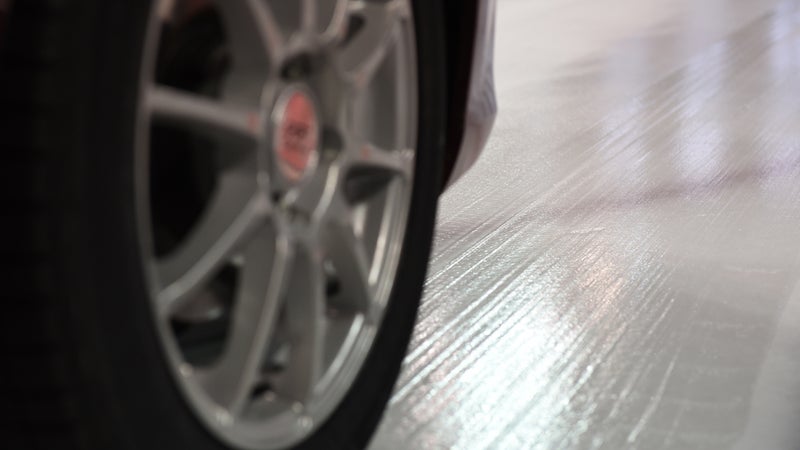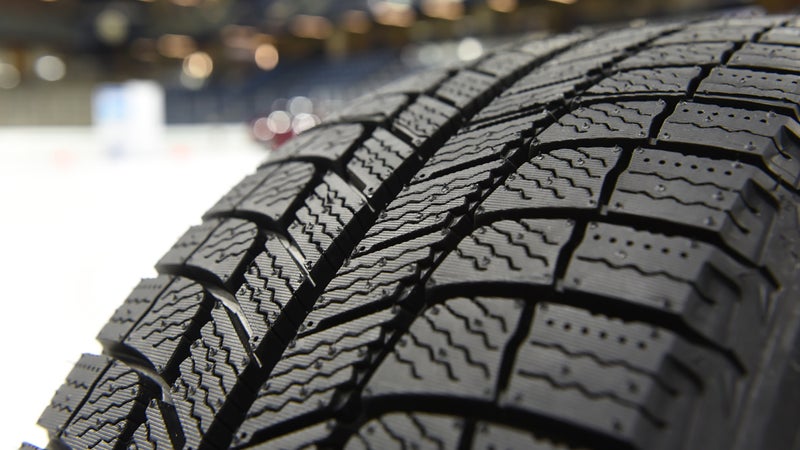One could argue that automakers are responsible for making roads more dangerous during the winter. By putting their vast marketing budgets behind the promotion of all-wheel drive as a safety feature, they’re hiding the one thing that actually makes it safer to drive on snow and ice, and even on dry roads, in cold temperatures: a good set of winter tires. It’s tires, not which wheels on your car are driven, that matter this winter.
“No doubt, an AWD vehicle on decent all-season tires will get moving pretty well,” explains Woody Rogers. He’s the head of Tire Rack’s testing team, so he has evaluated virtually every tire there is, in a variety of conditions. “But with AWD, you can get moving easily enough that you can overestimate your ability to stop and turn. Every vehicle uses the same four contact patches to stop and turn. AWD is not a benefit there.”
The all-season tires that come standard on most vehicles (including all-wheel drives) should, despite their name, be thought of only as a compromised three-season option, at best. They may be adequate in mild temperatures, but their ability to provide any grip at all falls off as temperatures drop, and they’re not equipped to provide grip on snow and ice. What follows is a broad explanation of how winter tires differ from “all-season” ones.
Modern Winter Tires Were First Developed in Japan, in the Early ‘90s
“The air quality in Japan was falling off during winter months due to studded tires chipping away at bare pavement, creating airborne dust,” says Rogers.
Studded tires are primarily designed to boost traction on ice, where the sharp steel studs dig into the surface to find grip. Studs don’t really help on snow and can actually reduce traction in slush or rain, and damage bare pavement. Drivers can’t dictate the surfaces they drive on, they just need a tire that works across all the hazardous conditions they face in winter months.
“So, Bridgestone [a Japanese tire maker] set about developing a studless winter tire,” continues Rogers. “They wanted to create a tire that wouldn’t just work in the snow, but on ice, too.”

They're Made from a Specialized Rubber Compound
“You can think of an all-season tire like a candy bar,” says Rogers. “At room temperature, it’s nice and gooey and tastes great. But, put it in the freezer for an hour and you can shatter the thing. The rubber in your tires will do the same thing at extreme temperatures.”
“Flexibility determines your tire’s traction,” he continues. “Somewhere in the 40- to 45-degree range is where we begin to see all-season tires lose traction. The rubber becomes very stiff; it can’t conform to the texture of the pavement, and stops providing traction.”
Winter tires are made from a different rubber compound than all-season tires. Where an all-season works optimally from about 45 degrees, up to 100 or so, a winter tire is made from a compound designed to work best below that 45-degree point. (They actually grip fine in warmer temperatures, they just wear out very quickly.) By remaining flexible at low temperatures, a winter tire is able to provide safe levels of grip, even on dry pavement.
Like a Merino Baselayer, Winter Tires Wick Moisture
“A big mechanical problem with tire traction on ice is that, as your vehicle rolls across it, the weight and friction in your contact patch melts a very thin film of water in the moment that it’s underneath the tire,” describes Rogers. “You have a lubricant over an already slippery surface, so your tire isn't even completely in contact with the ice.”
Conditions also change rapidly during the winter. Snow can turn to slush, or ice in an instant. And even what looks like dry pavement can be covered with patches of invisible black ice. It’s the winter tire’s job to provide drivers with predictability and grip throughout all that.
How? “Bridgestone’s big innovation was that they developed something called a multi-cell rubber compound that’s actually slightly porous,” says Rogers. “It works a lot like the technical fabrics in your outdoors gear, wicking moisture away from the surface. The multi-cell compound has empty, void space at a slightly-larger-than-molecular level. It gives the moisture somewhere to go temporarily, putting the rubber in contact with the texture of the ice surface.”
By allowing the tire to interact with the ice directly, it’s able to achieve grip. Other tire brands have adopted the technology as well, and it’s a big part of what makes the studless winter tire such great performers.
Their Tread Grips Much Better
Looking at a winter tire next to an all-season, it’s immediately obvious that the former has a much deeper, more open tread pattern that’s covered in small squiggly grooves. These add additional edges to help the tire find more traction. “These additional edges are called sipes,” explains Rogers. “They’re biting edges that provide the traction once the tire is in contact with the surface.”
The zig-zag pattern of the sipes makes them multi-directional. They add bite both front-and-rear, and side-to-side. Because they’re smaller and more flexible than the main tread pattern, they’re able to mechanically key with smaller imperfections in the surface you’re driving across. Think rough ice, or the grittiness in a paved surface.
Of course, the larger, deeper tread provides mechanical traction too, while also better clearing water and slush. “That way you take big bites out of the snow, rather than just nibbling at it,” says Rogers.

Winter Tires Can Actually Save You Money
A set of winter tires is going to cost you $500 to $800, or more, depending on your vehicle. You’ll also need to pay a shop to fit and remove them every November and April or invest in a second set of wheels to permanently mount them to. Sound expensive? In all likelihood, they’ll actually save you money.
“Most insurance deductibles are $500,” say Rogers. “If they save you just one little bump in traffic, you’ve paid for most of your winter tires.”
They’ll also extend the life of the tires you run the rest of the year. “Statistics say you’ll own your vehicle about six years,” says Rogers. “And, in that time, you’ll go through two sets of tires. By buying winter tires, you move forward the cost of that replacement. You can easily stretch six years and five winters out of that combination, with no significant additional expense.”
But where do you store those tires that aren’t on your vehicle? “If you stack them up in a corner, they’re less than 30 by 30 inches,” explains Rogers. “That’s smaller than a couple boxes of my stuff from high school.”
And because you’ve now learned that it’s tires, not AWD that you need to drive safely in winter weather, you can also now save money by buying a cheaper car. On models where AWD is offered as an option, it typically comes at a $1,000 to $1,500 premium. Spend that on tires instead, and you’ll have a car that stops and turns as well as it accelerates.
Which Winter Tires Are Right for You?
The short answer: Any of them. “Even an average winter tire is going to be better on snow and ice than the best all-season tire can ever hope to be,” says Rogers. Literally any studless winter tire will improve your ability to drive in the winter.
He’s frank about what a challenge it is to convince people they need to invest in winter tires. You can explain that all-seasons stop working below 40 degrees. You can explain that you need winter tires in order to stop and turn on snow and ice. Countless web videos demonstrate that, on snow and ice, an AWD car on all-seasons can’t out-accelerate a rear-wheel drive car on winter tires. But until people try them, they just don’t understand what a night and day difference we’re really talking about here. Rogers also notes one other finding from his decades of experience: “We know once a customer tries winter tires in real winter conditions, they’re never going to go back.”
“We’re all better off if we have good traction,” Rogers concludes. “As I drive around on appropriate tires, I don’t have to worry about what I can drive through, I have to worry about the people around me. The people behind me who can’t stop; the people who can’t steer to avoid a hazard. Please, Mr. and Mrs. Reader, do the rest of us a favor and be on winter tires.”

